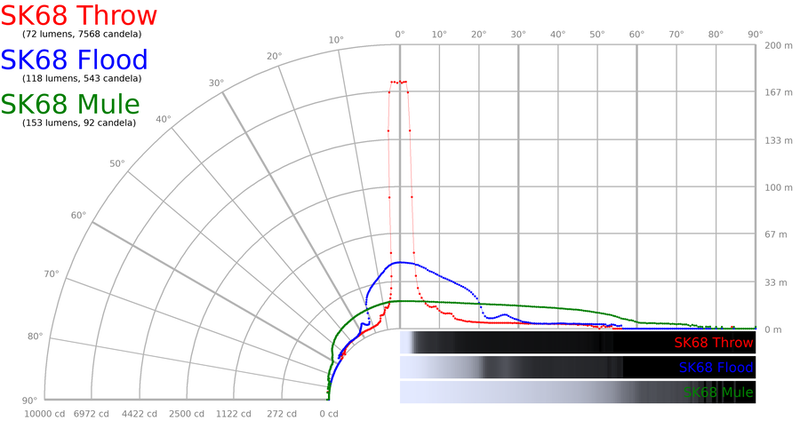parametrek
Enlightened
- Joined
- Apr 3, 2013
- Messages
- 578
I thought you guys might like to see what I've been up to:

You are looking at a chart of the intensity of a flashlight beam, measured with 0.5 degree accuracy. This is white wall hunting taken to the next level. I've chosen the SK68 for this test because it has the worst beam of anything that I own and a wide variety of beam shapes. You can plainly see the ringiness.
The right hand side is a simple graph of intensity vs angle. The left hand side is a polar version of the same chart. The polar version is very similar to a sideways "table" beamshot. Underneath the plots are a simulated render of what the beam pattern would look like.
These charts were produced automatically using $100 worth of hardware. It requires that the light have flatly regulated output. (Normally this requires running on a regulated medium mode and not turbo. But a little math can scale the numbers up to max output.) It can also measure the exact number of lumens, without any calibration.
Now, these tools are not yet ready for public release. I'm still cleaning up the software. Right now it is very poorly organized and everything is hard coded. It'll be a couple of weeks, tops.
However this is also the best time for me to add any features people might want. So I'm taking suggestions and answering questions.
If you already know that you want one, then you can start collecting the parts. The most difficult and crucial component is the usb luxmeter. You want either the GM1020 or UT382. I prefer the GM1020, but the UT382 is more common. It is dramatically easier to get these meters running under Linux by the way. Here's a thread about my work with them: http://www.candlepowerforums.com/vb/showthread.php?423071
I'd love to help as many people as possible assemble one of these systems for their reviews. Full details and build instructions to come!

You are looking at a chart of the intensity of a flashlight beam, measured with 0.5 degree accuracy. This is white wall hunting taken to the next level. I've chosen the SK68 for this test because it has the worst beam of anything that I own and a wide variety of beam shapes. You can plainly see the ringiness.
The right hand side is a simple graph of intensity vs angle. The left hand side is a polar version of the same chart. The polar version is very similar to a sideways "table" beamshot. Underneath the plots are a simulated render of what the beam pattern would look like.
These charts were produced automatically using $100 worth of hardware. It requires that the light have flatly regulated output. (Normally this requires running on a regulated medium mode and not turbo. But a little math can scale the numbers up to max output.) It can also measure the exact number of lumens, without any calibration.
Now, these tools are not yet ready for public release. I'm still cleaning up the software. Right now it is very poorly organized and everything is hard coded. It'll be a couple of weeks, tops.
However this is also the best time for me to add any features people might want. So I'm taking suggestions and answering questions.
If you already know that you want one, then you can start collecting the parts. The most difficult and crucial component is the usb luxmeter. You want either the GM1020 or UT382. I prefer the GM1020, but the UT382 is more common. It is dramatically easier to get these meters running under Linux by the way. Here's a thread about my work with them: http://www.candlepowerforums.com/vb/showthread.php?423071
I'd love to help as many people as possible assemble one of these systems for their reviews. Full details and build instructions to come!

